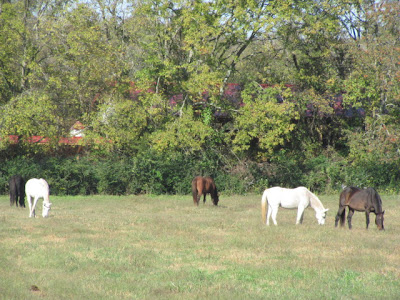This morning Melissa was in charge of the farm while I attempted to buy some new tires for the truck. When I got home I went out to check on a couple of Melissa's horses and on the cows in the back field. It was wet and cool this morning, so I thought I'd be a nice guy and blanket her horses, except that I wound up not being able to locate one blanket. When you run a retirement farm you always have several spare blankets on hand, so I selected one and applied it to the naked horse. Problem solved, or so I thought.
As I stood filling the cow trough with water, the phone rang. It was Melissa. I explained about the blanket and I proudly explained my solution. She told me to take the blanket off, immediately. Huh ? Is the blanket contaminated ? No, the blanket is missing one strap. I'm thinking to myself one piece of twine and two minutes and the blanket isn't missing a strap any more, but to my credit I didn't say it. The horse was smiling and happy, standing warm in it's minus-one-strap blanket twenty feet away from me. My wife was several miles away and telling me to take the blanket off. I took the blanket off.
She then told me that the cows didn't need water, and she said this knowing I was standing right in front of their mostly empty trough. (I feel the need to jump in here since what I actually said was "the cows shouldn't need water," but Jason's less than stellar hearing is well known in our world ...) Now folks, I'll be the first one to admit I'm not very smart sometimes, but after a life time in the livestock business I'm smart enough to know when the cows need water. What I'm not smart enough to do is to figure out an answer to a wife who's telling me something that is patently incorrect that doesn't lead immediately into an argument. I thought about not acknowledging her at all except to take a picture (yes but were you also going to include a picture of the other two troughs that were full? Just asking because I know how much it is annoying you to read this right now. Hopefully you aren't wondering why I'm giggling right now.) and send it to her but I didn't do that either. So I scratched my head, got confused and then mad and came to the house instead.
Anyone recognize themselves here ?
_________________________________
Johnny keeping watch while Rampal napped

Missy (unbelievably, we put sheets on a few horses again a couple of nights ago. Crazy October weather!!)

Cuffie

Calimba letting out a big yawn while hanging out in the shed

Lily and Norman (we're finally getting more fall color!)

Dutch napping in the sun

Murphy

Clay, Chili, Darby and Lighty

Romeo and Asterik were surrounded by so much fog my poor little point and shoot camera could not focus on them

Gus and George

Silver, Faune, Winston and Fonzi













































